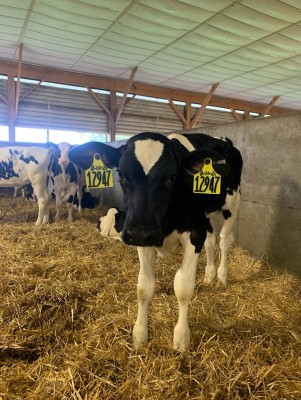7 Steps to Start Calves on Starter

Aggressively consuming dry feeds is the gateway to healthy weaning for young dairy calves. But many calves are reluctant to begin consuming starter grain, especially if they are on a nutrient-heavy liquid ration.
The sooner calves eat enough dry feed to sustain themselves, the better equipped they are to bridge the nutritional gap between the fixed liquid ration and a weaned diet of solely dry feeds - without stalled growth or health setbacks.
Michigan State University Dairy Extension educator Faith Cullens-Nobis says calves should be consuming enough starter to smoothly continue a healthy average daily gain (ADG) as they transition through weaning.
"It is very important that the calf can continue on a high growth pattern - and not diminish the excellent weight gains from an accelerated milk-feeding program - after they are weaned," She says. She suggests calves weaned at 6 weeks of age or less should be consuming 2.0 lb. to 3.0 lb. of starter grain per head per day for three consecutive days before weaning. Larger calves that are weaned later or have been on an intensive milk-feeding program need to be eating 4.0 to 5.0 pounds/head/day.
Cullens-Nobis, along with Nick Stagg, calf and heifer specialist for Purina Animal Nutrition, offers seven ideas to help get young calves consume starter grain:
1. Start early - Begin offering starter grain as early as day 3 of life, and definitely within the first week.
2. Small servings - In the beginning, make just a handful of fresh grain available, and change it daily. Refusals can be fed to older animals; freshness for young calves is critical. Saliva contamination, flies, spoilage and mold growth all can discourage starter intake.
3. Shallow vessels - Calves don't like to put their heads down into unfamiliar buckets or troughs, so it is important to serve starter grain in a shallow bowl or basin, where they can see, smell and explore it. You may be able to find bowls that rest right inside the more-permanent pails you will use for grain when calves are slightly older.
4. Hand-feeding - Try putting a small amount of grain directly into the calf's mouth right after they have nursed a nipple, when they are most curious.
5. Fresh water - Begin offering clean, fresh water as soon as starter grain is offered, and change it daily as well. A large body of research has shown that not only does water intake aid in the digestion of starter grain and rumen development, but it encourages greater grain consumption.
6. Separate structures - Place a divider between starter grain and water - or locate pails at a distance from one another -- to preserve freshness and avoid cross-contamination of both.
7. Steady supply - Don't let calves run out of starter grain. As their intake increases, offer more at each feeding so they consistently have access to it free-choice.
Upcoming Events
Crops, Cows & Critters - Southwest New York Dairy, Livestock & Field Crops Newsletter Sponsorship
December 19, 2025
Our two forms of publications feature research-based and timely information from our four specialists, listed to the right, along with local event notifications and Cornell University outreach. This information is provided to participants who range from dairy, livestock, and field crops producers to agricultural suppliers and consultants.
Weekly Email Update: Shared with 625+ households who have signed up with our program.
Monthly Paper Mailer: To reach our stakeholders and farmers who lack internet access, we send out a monthly mailer where your company's logo and contact information would be featured with a mailing list of 330+ households.
If you sponsor our weekly and monthly publications you reach approximately 955 households.
Visit our website to view our newsletters!
2025 Cornell Food Beverage & Animal Feed Manufacturer Survey
December 19, 2025
Industry and Educational Advocates for New York State's Food, Beverage, and Animal Feed Manufacturing industries:
As you know, NYS has a diverse food and beverage manufacturing industry, in both the types of industries that exist and the wide distribution of firms by scale. Many manufacturing firms have strong backward linkages to agricultural production sectors in the state that support both farm-level and downstream food industry firms and consumers. In collaboration with the New York State Department of Agriculture and Markets, a team from Cornell University's Charles H. Dyson School of Applied Economics and Management has recently rolled out the 2025 New York State Food, Beverage, and Animal Feed Manufacturer Survey. The industry will benefit from an updated assessment of the industry that informs private and public investments and opportunities to support firm growth and improved profitability.
Cornell Organic Field Crops & Dairy Conference
March 6, 2026
Waterloo, NY
Farmers, researchers, educators, and agricultural service providers from across the Northeast are invited to the 2026 Cornell Organic Field Crops & Dairy Conference, held Friday, March 6, 2026, from 8:00 a.m. to 4:30 p.m. at the Lux Hotel & Conference Center in Waterloo, N.Y.
Co-hosted by New York Soil Health and Cornell CALS, the annual conference brings together leaders in organic grain, dairy, and livestock systems to share practical tools, new research, and farmer-tested strategies to support resilient and profitable organic production.
Announcements
No announcements at this time.





